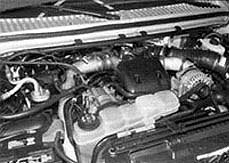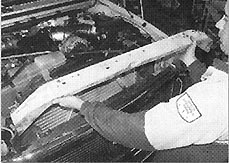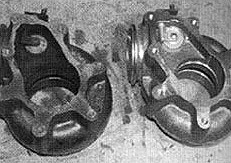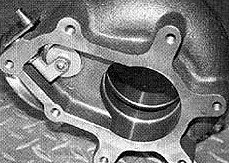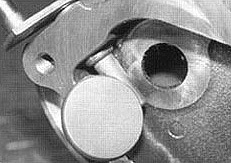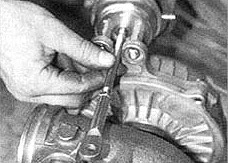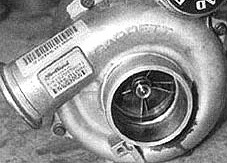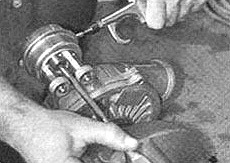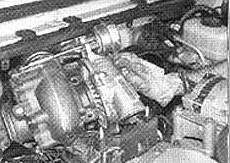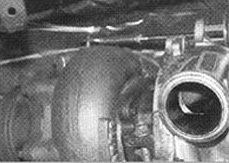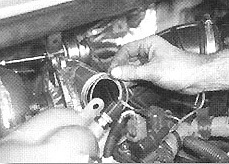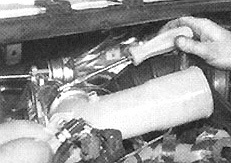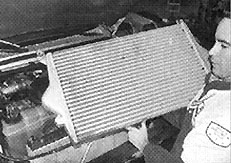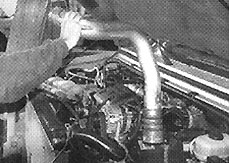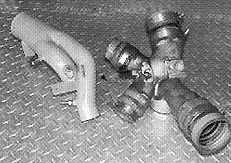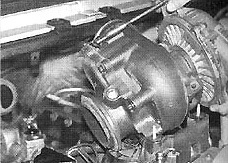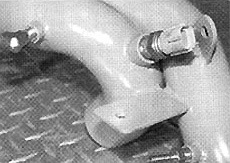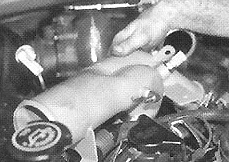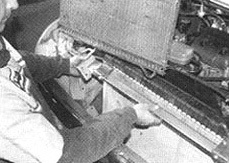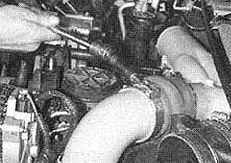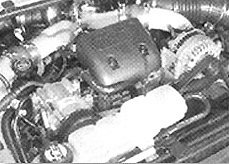Hair Dryer Horsepower
Off-Road - a Primedia Publication August 2000
Feature on Banks PowerPack and Stinger-Plus systems for new generation Ford Power Strokes
| The Banks PowerPack® System consists of the following components: • Techni-Cooler intercooler: Provides maximum boost air density, while reducing boost pressure loss to a minimum. It also provides improved airflow to the engine by 18 percent and improves density recovery by as much as 30 percent. This means that the engine will inhale cooler, denser air than what the factory intercooler allows without compromising airflow to the radiator for engine cooling.• Rubber shock mounts, powdercoated steel boost tubes, and flexible, high-temperature silicone hoses connect the intercooler inlet and outlet tubes of the system.• The TwinRam manifold inlet assembly is designed to be less restrictive than the OEM stock inlet manifold. The straight-line design is more direct to the intake manifold of the engine, creating better airflow.• The OttoMind engine calibration module is the brain of the system. This unit plugs into an access port on the vehicle’s OE computer and readjusts the fuel calibration to match the airflow improvement.• The BigHead wastegate actuator’s firmer resistance prevents the turbo’s wastegate from being blown open, creating more midrange boost. The BigHead actuator has a 110 percent greater diaphragm surface area to maintain control of the wastegate, developing more useable mid-rpm power. This allows an enhanced torque curve with the proper fuel calibration. • The Banks Ram-air filter is a high-flow reusable filter element that replaces the restrictive factory paper element. • The stainless steel acoustic-tuned Dynaflow muffler is specifically designed to give a quality sound that is not too loud, while not restricting airflow. The straight-through design incorporates a ceramic fiber packing with a stainless steel mesh to avoid melting or a blowout of the packing material.• A stainless steel, 3-1/2-inch-diameter Monster tailpipe with a polished stainless steel tailpipe tip.• A stainless Monster T.O.P. (turbine outlet pipe).• A DynaFact pyrometer (EGT) and boost gauges are included for proper monitoring of the engine’s vital signs.• A two-gauge A-pillar molded mounting panel allows for simple and clean installations (available separately).• A Banks TransCommand (4R100 automatic transmission) electronically adjusts line pressure in the transmission according to load in order to maintain sufficient line pressure in relation to input torque. |

Better Boost for the Ford F-350 Super Duty Power Stroke Diesel
Gale Banks has become a horsepower legend over the years, developing and manufacturing high-performance engine components and turbocharging systems for racing, street, and off-road applications. Gale Banks Engineering prides itself on designing high-quality parts and components to increase engine power, performance, and reliability. Today’s 4×4 truck market is one of Banks’ major divisions, and Ford’s Power Stroke diesel is a natural for Banks’ upgrades.
Banks Engineering is one of the true leaders in the industry of engine airflow management. The secret is to be able to remove the airflow restrictions in the intake and exhaust systems. The team at Banks can safely increase the fuel delivery, creating more power and torque. The Banks OttoMind is custom calibrated to each vehicle application to maintain the optimal air/fuel ratio and safe exhaust gas temperatures (EGT). By improving the engine’s airflow, Banks develops better mileage and diesel durability. Working with product manager Jeff White and engineering manager Peter Treydte enabled Off-Road magazine to get a clear perspective of the product and its designed functions and features.
To increase the torque and the horsepower of a ’99 Ford F-350 Super Duty Power Stroke 7.3L Turbo Diesel, we followed Zane Messenger as he installed a Banks PowerPack® system.
The PowerPack includes a Banks Ram-Air free-breathing lifetime filter to replace the stock paper air filter element. The Banks OttoMind engine calibration module alters the shape of the fuel curve to match the improved airflow and to optimize the power at the proper shift points. For the exhaust, Banks replaces the restrictive factory exhaust plumbing for a stainless, free-flowing Monster T.O.P. (turbine outlet pipe), a Dynaflow muffler and a stainless 3-1/2-inch constant-diameter Monster tailpipe with a girthy 4-inch polished tip.
After bolting all the goodies on, the mighty Ford 7.3L Power Stroke showed impressive power gains, especially in bottom-end torque. Here’s what it takes to really get smokin’ diesel performance. OR
| Stock | Banks PowerPack | Horsepower | Gain | Percentage of Improvement |
|---|---|---|---|---|
|
Peak-to-peak hp
|
212.2 @ 2,700 rpm
|
292.0
|
@ 3,000 rpm + 79.8 hp
|
37.6
|
|
Best hp gain
|
193.2 @ 3,000 rpm
|
284.1
|
@ 3,000 rpm + 90.9 hp
|
47.0
|
|
peak-to-peak torque
|
463.1 @ 1,800 rpm
|
658.0
|
@ 1,800 rpm + 194.9 lb-ft
|
42.1
|
|
Best torque gain
|
453.5 @ 1,700 rpm
|
650
|
@ 1,700 rpm + 180.8 lb-ft
|
43.3
|
